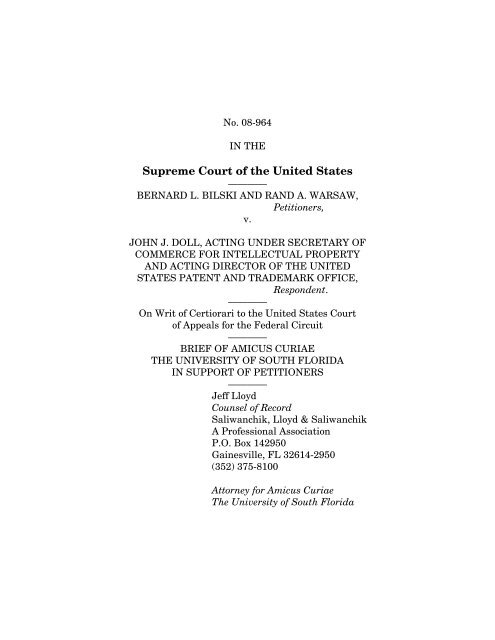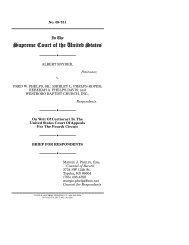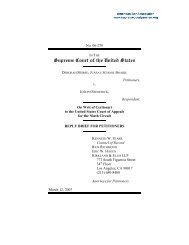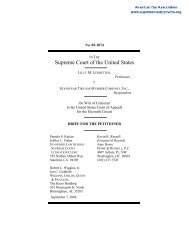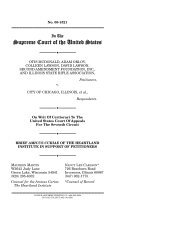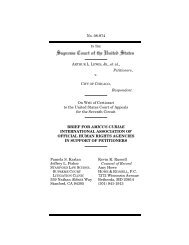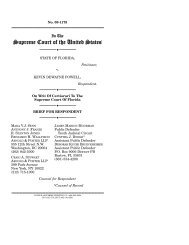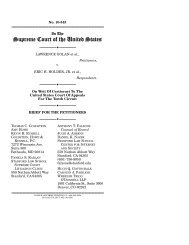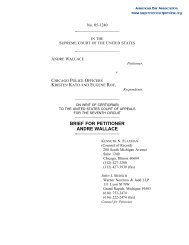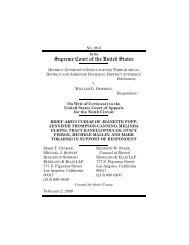Brief of petitioner for Bilski v. Doll; 08-964 - Oyez
Brief of petitioner for Bilski v. Doll; 08-964 - Oyez
Brief of petitioner for Bilski v. Doll; 08-964 - Oyez
Create successful ePaper yourself
Turn your PDF publications into a flip-book with our unique Google optimized e-Paper software.
iTABLE OF CONTENTSTable <strong>of</strong> Contents ........................................................ iTable <strong>of</strong> Cited Authorities ......................................... iiInterest <strong>of</strong> Amicus Curiae.......................................... 1Summary <strong>of</strong> the Argument ........................................ 3Argument.................................................................... 4I. The Federal Circuit’s new test is overly restrictive. ..4II.The Framers <strong>of</strong> the Constitution intended to promoteadvances in medical diagnosis and treatment. ...................6III. Congress intended advances in medical diagnosis andtreatment to be patentable subject matter.........................12Conclusion ................................................................ 16
1INTEREST OF AMICUS CURIAE 1The University <strong>of</strong> South Florida (hereinafter,“USF”) is the nation’s ninth largest public universityand a leading research institution. Founded in 1956,USF has over 46,000 students and more than 13,000faculty and staff members, with an annual operatingbudget in excess <strong>of</strong> $1.8 billion dollars. USF’smission includes research and scientific discovery <strong>for</strong>the generation, dissemination, and translation <strong>of</strong>new knowledge across disciplines; to strengthen theeconomy; to promote civic culture and the arts; andto design and build sustainable, healthycommunities. Fueled by its research ef<strong>for</strong>ts, USFhas a substantial economic impact on its regionestimated at over $3.2 billion dollars annually.USF medical researchers strive to expand thefrontiers <strong>of</strong> medicine, searching <strong>for</strong> improvedmethods <strong>of</strong> diagnosing, prognosing, and treatingdiseases such as cancer, HIV, diabetes, andneurological disorders such as Alzheimer’s andParkinson’s diseases. USF is one <strong>of</strong> the top 501 In accordance with Supreme Court Rule 37, amicus curiaestates that this brief was not authored in whole or in part bycounsel <strong>for</strong> any party, and that no monetary contribution to thepreparation or submission <strong>of</strong> this brief was made by any personor entity other than amicus curiae or its counsel. Counsel <strong>of</strong>record <strong>for</strong> all parties were timely notified 10 days prior to thefiling <strong>of</strong> this brief. Petitioners have consented to the filing <strong>of</strong> allamicus curiae briefs in support <strong>of</strong> either or neither party, andrespondent has consented to the filing <strong>of</strong> this brief via aseparate letter <strong>of</strong> consent dated July 14, 2009. A copy <strong>of</strong> thisletter has been filed with the Clerk <strong>of</strong> the Court.
3SUMMARY OF THE ARGUMENTThe Federal Circuit’s “machine-ortrans<strong>for</strong>mation”test is more restrictive than anySupreme Court precedent, excluding from patenteligibility certain processes that Congress intendedto be patent eligible. The test has been applied toinvalidate issued claims directed to certain medicalmethods. There is no legislative basis <strong>for</strong> such arestriction. Methods that promote the progress <strong>of</strong>medicine, diagnosis and treatment in particular,were clearly contemplated by the Framers <strong>of</strong> theConstitution as well as members <strong>of</strong> Congress to bepatent eligible. Courts should not read into thepatent laws limitations and conditions whichCongress has not expressed. Despite this, theFederal Circuit adopted the “machine-ortrans<strong>for</strong>mation”test as the sole test <strong>for</strong> patenteligibility <strong>of</strong> a process, thereby excluding from patenteligibility subject matter that Congress clearlyconsidered patent eligible. This was error. The firstquestion presented should be answered in theaffirmative, and the Federal Circuit’s error should bereversed.
4ARGUMENTI. The Federal Circuit’s new test is overlyrestrictive.The Federal Circuit’s holding that a processclaim that “neither recites a particular machine orapparatus, nor trans<strong>for</strong>ms any article into adifferent state or thing, is not drawn to patenteligiblesubject matter” unnecessarily, unwisely, andimproperly excludes from patent protectiontechnologies that Congress clearly intended to bepatentable. In re <strong>Bilski</strong>, 545 F.3d 943, 961 (Fed. Cir.20<strong>08</strong>). This “machine-or-trans<strong>for</strong>mation” test isuseful as a starting point <strong>for</strong> determining whetherprocess claims are directed to patent eligible subjectmatter. This Court has held that the “machine-ortrans<strong>for</strong>mation”test is sufficient to qualify a processclaim as patent eligible, but the Court has declinedto state that passing this test is a necessaryrequirement <strong>for</strong> the patent eligibility <strong>of</strong> a processclaim. See Parker v. Flook, 437 U.S. 584, 588 n.9(1978); Gottschalk v. Benson, 409 U.S. 63, 71 (1972).Excluding from patent eligibility certain processesinvolving medical diagnosis and treatment merelybecause they do not recite a particular machine orapparatus or trans<strong>for</strong>m an article into a differentstate or thing is improper, as such processes areunquestionably within the realm <strong>of</strong> patent eligiblesubject matter. Yet this is exactly what the FederalCircuit’s “machine-or-trans<strong>for</strong>mation” test has done.The Federal Circuit first applied its new“machine-or-trans<strong>for</strong>mation” test in a singleparagraph,nonprecedential opinion in Classen
5Immunotherapies, Inc. v. Biogen IDEC, affirming adistrict court judgment invalidating claims tomethods <strong>of</strong> immunizing a mammalian subject. 2 304F.App’x 866 (Fed. Cir. Dec. 19, 20<strong>08</strong>), reh’g denied enbanc reh’g denied (Feb. 9, 2009). While the claims atissue might well have been found invalid on othergrounds (<strong>for</strong> example, as obvious or anticipated), asdiscussed below, they are certainly within the realm<strong>of</strong> subject matter contemplated as patent eligible bythe Framers <strong>of</strong> the Constitution and Congress. Thus,applying the “machine-or-trans<strong>for</strong>mation” test as the2The district court had summarized the Classen claims asrequiring “1) comparing the incidence <strong>of</strong> immune mediateddisorders in treatment groups with different vaccinationschedules; and 2) immunizing patients on a schedule identifiedas low risk.” Classen Immunotherapies, Inc. v. Biogen IDEC,Civil No. WDQ-04-2607, 2006 WL 6161856, at *5 (D. Md. Aug.16, 2006). Rather than properly construing the claims as “amethod <strong>for</strong> reducing the incidence <strong>of</strong> chronic immune mediateddisorders” and recognizing that an improved process <strong>of</strong>vaccination is a human invention, the district court held thatthe claims describe a natural correlation. Id. Characterizingthe correlation between vaccination schedules and incidents <strong>of</strong>immune mediated disorders as a natural phenomenon, thecourt held the claims invalid as an attempt to patent a naturalphenomenon. Id. The district court’s reasoning was faulty: theexistence <strong>of</strong> an immune response in mammals is a naturalphenomenon. Human experimentation, manipulation, andoptimization <strong>of</strong> the immune response to achieve beneficialresults is not a natural phenomenon. On appeal, the FederalCircuit did not discuss whether the claims describe a naturalphenomenon. Instead, the panel applied the new test withoutanalysis, declaring “Dr. Classen’s claims are neither ‘tied to aparticular machine or apparatus’ nor do they ‘trans<strong>for</strong>m[ ] aparticular article into a different state or thing.’ There<strong>for</strong>e weaffirm.” Classen, 304 F.App’x at 867 (quoting In re <strong>Bilski</strong>, 545F.3d. at 954) (alteration in original).
only test <strong>for</strong> patent eligibility is clearly improper.6II.The Framers <strong>of</strong> the Constitutionintended to promote advances in medicaldiagnosis and treatment.The Constitution grants Congress broad powerto legislate to “promote the Progress <strong>of</strong> Science anduseful Arts, by securing <strong>for</strong> limited Times to . . .Inventors the exclusive Right to their . . .Discoveries.” U.S. CONST. art. I, § 8, cl. 8. At thetime the Constitution was drafted, medicine had <strong>for</strong>more than two thousand years been known as one <strong>of</strong>the “useful Arts.” The Oath <strong>of</strong> Hippocrates refers tomedicine as “the art,” “this art,” or “my art” on fiveoccasions. HIPPOCRATES, THE OATH AND LAW OFHIPPOCRATES, reprinted in 38 HARVARD CLASSICS, pt.1 (Charles W. Eliot ed., P.F. Collier & Son 1910)(1909). The first sentence <strong>of</strong> The Law <strong>of</strong> Hippocratesstates “Medicine is <strong>of</strong> all the Arts the most noble; butowing to the ignorance <strong>of</strong> the ones who practiceit, . . . it is at present far behind all the other arts.”Id. In the late 18th century, those who wereeducated in classical learning included ThomasJefferson, and they were well aware that medicinewas one <strong>of</strong> the “useful Arts.”In Graham v. John Deere, this Court discussedthe legislative history <strong>of</strong> patent law at length,including analysis <strong>of</strong> the influence <strong>of</strong> ThomasJefferson on the development <strong>of</strong> our patent system,noting “[b]ecause <strong>of</strong> his active interest and influencein the early development <strong>of</strong> the patent system,Jefferson’s views on the general nature <strong>of</strong> the limitedpatent monopoly under the Constitution, as well as
7his conclusions as to conditions <strong>for</strong> patentabilityunder the statutory scheme, are worthy <strong>of</strong> note.”383 U.S. 1, 7 (1966). As illustrated below,Jefferson’s writings and other writings <strong>of</strong> his timeindicate that medicine, including methods <strong>of</strong>treatment and diagnosis, would have been includedin the Framers’ definition <strong>of</strong> “useful Arts.”In Jefferson’s time and in Jefferson’s mind,medicine was clearly understood to be one <strong>of</strong> the“useful Arts.” The first edition <strong>of</strong> the EncyclopædiaBritannica states:Medicine is generally defined to be, The art<strong>of</strong> preserving health when present and <strong>of</strong>restoring it when lost . . . . Most arts requirethe experience <strong>of</strong> ages be<strong>for</strong>e they can arriveat a high degree <strong>of</strong> perfection. Medicine isunquestionably one <strong>of</strong> the most ancient; andconsequently, the improvement <strong>of</strong> it might beexpected to bear some proportion to itsantiquity but, whilst philosophy, in all itsbranches, has been cultivated and improvedto a great extent; medicine, not withstandingthe collateral advantages it has <strong>of</strong> latederived from anatomy and other sciencesstill continues to be buried in rubbish andobscurity.3 A SOC’Y OF GENTLEMEN IN SCOT., ENCYCLOPÆDIABRITANNICA 58 (1st ed. 1771) [hereinafterENCYCLOPÆDIA BRITANNICA] (emphasis added).Jefferson’s letters make clear that he consideredmedicine to be one <strong>of</strong> the “useful Arts” in need <strong>of</strong>
8advancement through both observation andinnovation. For example, in his letter on “Freedom<strong>of</strong> Mind” to William Green Mun<strong>for</strong>d dated June 18,1799, Jefferson states:Surgery is well advanced; but prodigiouslyshort <strong>of</strong> what may be. The state <strong>of</strong> medecine[sic] is worse than that <strong>of</strong> total ignorance . . . .We have a few medecines, as the bark, opium,mercury, which in a few well defineddiseases are <strong>of</strong> unquestionable virtue: butthe residuary list <strong>of</strong> the materia medica, longas it is, contains but the charlataneries <strong>of</strong>the art; and <strong>of</strong> the diseases <strong>of</strong> doubtful <strong>for</strong>m,physicians have ever had a false knowledge,worse than ignorance. Yet surely the list <strong>of</strong>unequivocal diseases & remedies is capable<strong>of</strong> enlargement; and it is still more certainthat in the other branches <strong>of</strong> science, greatfields are yet to be explored to which ourfaculties are equal, & that to an extent <strong>of</strong>which we cannot fix the limits. I join youthere<strong>for</strong>e in branding as cowardly the ideathat the human mind is incapable <strong>of</strong> furtheradvances.THOMAS JEFFERSON, WRITINGS 1065 (Merrill D.Peterson ed., Library <strong>of</strong> America 1984) (emphasisadded). Similar evidence is found in Jefferson’sletter entitled “Unlearned Views <strong>of</strong> Medicine” to Dr.Caspar, dated June 21, 1807. In this letter,Jefferson provides his opinions on the state <strong>of</strong>medicine and medical education:. . . [F]ulness <strong>of</strong> the stomach we can relieve
9by emetics; diseases <strong>of</strong> the bowels, bypurgatives; inflammatory cases, by bleeding;intermittents [fevers], by the Peruvian bark;syphilis, by mercury; watchfulness, byopium; etc. So far, I bow to the utility <strong>of</strong>medicine. It goes to the well-defined <strong>for</strong>ms<strong>of</strong> disease, & happily, to those the mostfrequent. But the disorders <strong>of</strong> the animalbody . . . are as various as the elements <strong>of</strong>which the body is composed . . . . To anunknown disease, there cannot be a knownremedy. Here then, the judicious, the moral,the humane physician should stop . . . . Butthe adventurous physician goes on, &substitutes presumption <strong>for</strong> knolege [sic] . . . .It is in this part <strong>of</strong> medicine that I wish tosee a re<strong>for</strong>m, an abandonment <strong>of</strong> hypothesis<strong>for</strong> sober facts, the first degree <strong>of</strong> value seton clinical observation, and the lowest onvisionary theories . . . . I would wish theyoung practitioner . . . to have deeplyimpressed on his mind, the real limits <strong>of</strong> hisart.Id. at 1181-1185 (emphasis added). Yet anotherexample can be found in Jefferson’s letter “TheValue <strong>of</strong> Classical Learning” to John Brazier datedAugust 24, 1819. Jefferson advocated studying theClassics in their original Greek and Latin and wasthoroughly familiar with the writings <strong>of</strong> Hippocrates.In discussing the benefits <strong>of</strong> classical learning and inparticular its utility to various members <strong>of</strong> society,Jefferson notes that the Greek and Roman textshave given to physicians:
10as good a code <strong>of</strong> his art as has been givenus to this day. Theories and systems <strong>of</strong>medicine, indeed, have been in perpetualchange from the days <strong>of</strong> the goodHippocrates to the days <strong>of</strong> the good Rush,but which <strong>of</strong> them is the true one? Thepresent, to be sure, as long as it is thepresent, but to yield its place in turn to thenext novelty, which is then to become thetrue system, and is to mark the vast advance<strong>of</strong> medicine since the days <strong>of</strong> Hippocrates.Our situation is certainly benefited bythe discovery <strong>of</strong> some new and very valuablemedicines; and substituting those <strong>for</strong> some <strong>of</strong>his with the treasure <strong>of</strong> facts, and <strong>of</strong> soundobservations recorded by him (mixed to besure with anilities <strong>of</strong> his day) and we shallhave nearly the present sum <strong>of</strong> the healingart.Id. at 1424 (emphasis added). Thus, substantialevidence exists that Jefferson and others <strong>of</strong> his timeconsidered the term “useful Arts” to encompassmedicine. Moreover, these letters indicate thatJefferson considered medicine, including medicaldiagnosis and treatment, to be a field in which greatprogress was both possible and needed <strong>for</strong> thebenefit <strong>of</strong> society.The 1771 edition <strong>of</strong> Encyclopædia Britannicaagain echoes Jefferson’s sentiments regarding theneed <strong>for</strong> progress in the “art” <strong>of</strong> medicine:In every art which is not founded on knownfacts and established principles, new projects
12the “useful Arts.” It is also clear that procedures <strong>for</strong>diagnosis and treatment <strong>of</strong> diseases were consideredarts within the more general art <strong>of</strong> medicine.Moreover, Jefferson and his contemporariesrepeatedly voiced an acute need <strong>for</strong> progress in theart <strong>of</strong> medicine. The Constitution was thus draftedwith an understanding <strong>of</strong> medicine as a “useful Art”in which “progress” was greatly desired.III.Congress intended advances in medicaldiagnosis and treatment to be patenteligible subject matter.From the first Patent Act, Congress has broadlydescribed the class <strong>of</strong> inventions eligible to beconsidered <strong>for</strong> Patents. Later acts <strong>of</strong> Congress madeclear that medicine, including methods <strong>of</strong> diagnosisand treatment, were meant to be included in thatdescription. As further discussed below, reading thePatent Act in a manner which excludes methods <strong>of</strong>diagnosis and treatment from the class <strong>of</strong> patenteligible inventions is contrary to the legislativehistory as interpreted by this Court.This Court has repeatedly recognized that thelegislative history <strong>of</strong> the Patent Act supports a broadconstruction <strong>of</strong> patent eligible subject matter. InDiamond v. Chakrabarty, this Court noted that:The Patent Act <strong>of</strong> 1793, authored by ThomasJefferson, defined statutory subject matteras “any new and useful art, machine,manufacture, or composition <strong>of</strong> matter, orany new or useful improvement [there<strong>of</strong>].”Act <strong>of</strong> Feb. 21, 1793, § 1, 1 Stat. 319. The
14matter provisions <strong>of</strong> the patent law have been cast inbroad terms to fulfill the constitutional andstatutory goal <strong>of</strong> promoting ‘the Progress <strong>of</strong> Scienceand the useful Arts’ with all that means <strong>for</strong> thesocial and economic benefits envisioned byJefferson.” Chakrabarty, 447 U.S. at 315. Asdiscussed above, advances in medicine, particularlymethods <strong>of</strong> diagnosis and treatment, were socialbenefits that Jefferson hoped <strong>for</strong> and envisioned.The current act provides further evidence thatCongress intended processes <strong>of</strong> diagnosis andtreatment to be patent eligible subject matter. In1996, the act was amended to explicitly excludemedical practitioners from liability <strong>for</strong> infringing apatent by the per<strong>for</strong>mance <strong>of</strong> a medical or surgicalprocedure on a body (including a human body, organ,or cadaver, or a non-human animal). OmnibusConsolidated Appropriations Act, 1997, Pub. L. No.104-2<strong>08</strong>, 110 Stat. 3009-67 (codified as amended at35 U.S.C. § 287(c) (2006)). Significantly, § 287excludes from its application the practice <strong>of</strong> patentedbiotechnology processes and certain pharmacy andclinical laboratory services, <strong>for</strong> which medicalpractitioners remain liable <strong>for</strong> patent infringement.35 U.S.C. § 287(c) (2006). The fact that Congress feltthe need to create such exclusions makes clear thatthey intended new and useful medical processes suchas methods <strong>of</strong> diagnosis or treatment to be patenteligible subject matter.In United States v. Dubilier Condenser Corp.,this Court cautioned: “We should not read into thepatent laws limitations and conditions which the
15Legislature has not expressed.” 289 U.S. 178, 199(1933). The Federal Circuit’s “machine-ortrans<strong>for</strong>mation”test as set <strong>for</strong>th in In re <strong>Bilski</strong> ismore restrictive than required by this Court’sprecedent and finds no support in any legislation. Inpractice, it has already been applied to strike downpatents directed to methods <strong>of</strong> immunizing patientswith improved efficacy and safety thereby casting acloud on the validity <strong>of</strong> a great many process patentsin the medical and biotechnological fields.The “machine-or-trans<strong>for</strong>mation” test is a usefulstarting point <strong>for</strong> analysis <strong>of</strong> patent eligibility <strong>of</strong>process claims. However, if a process claim is nottied to a particular machine or does not recitetrans<strong>for</strong>mation <strong>of</strong> an article into a different state orthing, the inquiry should not stop there, as theprocess may still be patent eligible as long as it doesnot attempt to claim “laws <strong>of</strong> nature, naturalphenomena, [or] abstract ideas.” Diamond v. Diehr,450 U.S. 175, 185 (1981). The inquiry shouldcarefully analyze whether the claimed process istruly claiming a phenomenon <strong>of</strong> nature, ever mindful<strong>of</strong> the difference between phenomena that areentirely products <strong>of</strong> nature and inventions that arethe result <strong>of</strong> how nature reacts to the purposefulactivity <strong>of</strong> man. Where the activities <strong>of</strong> man cause auseful, tangible, concrete result that did not existbe<strong>for</strong>e, the process should be considered patenteligible.
16CONCLUSIONThe Federal Circuit’s holding that a “process”must be tied to a particular machine or apparatus, ortrans<strong>for</strong>m a particular article into a different stateor thing, to be patent eligible is too restrictive. Theholding excludes subject matter that Congressclearly intended to be patent eligible. There<strong>for</strong>e,amicus curiae respectfully requests that the Courtreverse the decision <strong>of</strong> the Federal Circuit andanswer the first question presented in theaffirmative.Respectfully submitted,Jeff LloydCounsel <strong>of</strong> RecordSaliwanchik, Lloyd & SaliwanchikA Pr<strong>of</strong>essional AssociationP.O. Box 142950Gainesville, FL 32614-2950(352) 375-8100Attorney <strong>for</strong> Amicus CuriaeThe University <strong>of</strong> South Florida


